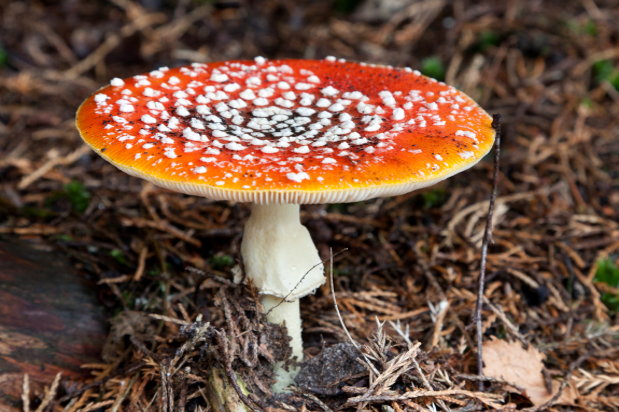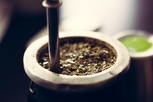Psychedelic mushrooms, also known as psilocybin, are a hallucinogenic drug. History records use of these mushrooms by indigenous peoples, since somewhere around 200 B.C. They were used by Native American peoples for religious and mystical ceremonies. Many stories surround the mystical deeds performed by seers, travelers and those with magical powers who used hallucinogenic mushrooms in traditions handed down by native peoples.
There are approximately 200 different species of mushrooms that contain psilocybin and produce the hallucinogenic properties associated with it. They are found primarily in tropical regions of the world, such as the Amazon, where rainfall keeps conditions for their growth viable. Because these regions house some of the oldest civilizations, use of "magic" mushrooms may pre-date our knowledge. Some historians believe they were part of an evolutionary process that included ancient peoples.
Psychedelic mushrooms became well-known in the mid-1950s, when a couple returned from Mexico and published an article in Time magazine recounting their experience with mushrooms. Following that article, several people who studied the psychedelic properties of both man-made and natural substances became interested in their use for possible mental illness treatment.
In more recent years, psychedelic mushrooms became popular during the advent of psychedelic "drug tripping" in the early 1960s and 1970s. Their popularity as one of the most-often used psychedelic drugs is widespread. Use of mushrooms remains active in several indigenous cultures as well. Native cultures in South and Central America continue to include mushrooms in religious rites and traditional ceremonies.
Mushroom Effects
Effects of psilocybin mushrooms are unique. They produce effects that last from 3-8 hours, which is a shorter time period than the effects produced by other psychedelic drugs. Their effects may be mild for some users, and more powerful for others, depending on several factors; such as amount taken and type of mushroom taken. Some mushrooms have stronger hallucinogenic properties, based on growing conditions and species of mushroom.
Hallucinations from Mushrooms
Visual hallucinations are the most-often reported effects of mushrooms. These can seem to alter space-time relationships as well. Some users report time elapsing at differing rates when under the influence of mushrooms. However, common effects for users include visual changes wherein intense colors and auras surround objects--a phenomenon not seen without psilocybin. Objects may seem to “pulse” with life, much like breathing, and swirl or dance. Vivid colors and a “bleeding” of objects into one-another are also commonly reported by users, who state that objects seem to merge or melt into each other. Sharp outlines or halos may appear for others.
Emotional Effects of Mushrooms
Many users experience a sense of belonging and well-being with the world around them. They experience a disappearance of boundaries and limitations; reporting a sense of unity and connection that is mystical and often spiritual in nature. These reports have led researchers to use this drug for many purposes in treating various mental health issues, especially depression and those that feature dissociative properties.
Some users experience high anxiety, panic attacks or paranoia with use of psilocybin. Their reports of “bad trips” may have been due to circumstances surrounding the conditions of use. Many users claim that the environment of use is important to the experience of the user.
Recommendations are a comfortable, safe environment; as well as conditions that are relatively free from sensory input. They should be quiet, with people who are considered safe for the user to enjoy the experience with, as well as having little or no sensory stimulation. For obvious reasons, users should never attempt to operate a motor vehicle or use any equipment while under the influence of the drug.
Another serious risk is that of using the wrong type of mushroom. Experienced users know the difference between poisonous and psilocybin mushrooms. Many others may not be able to make this distinction, and are at risk for using dangerous mushrooms that can be fatal.
How Addictive Are Mushrooms?
Users can develop a tolerance for psilocybin with frequent use. However, no dependence on the drug has been recognized. Therefore, it is safe to say that psilocybin mushrooms are not physically addictive. If a user takes them often, they may need to increase the dose to get the desired effects. This may also be true when using a type of mushroom that is different than the species they usually use. Some species have more potent effects than others.
Overdosing on Mushrooms
Users can possibly overdose on mushrooms, which is referred to as having a “bad trip.” They may experience frightening visual hallucinations or ideas which cause them to panic or become paranoid. Most often, a user can be talked down from this experience by a friend or trusted individual who remains calm and grounded. This is the reason experienced users recommend that those who are new to psychedelic experiences have a “guide” with them when taking mushrooms.
There are no deaths attributed to mushroom use, according to the research. While there are stories surrounding outrageous acts performed while under the influence of psychedelic drugs, there are no substantiated reports of this occurring. Some reports of users who believed they could fly or who performed dangerous acts while high are not in evidence.
Withdrawing from Mushrooms
The effects of mushrooms wear off after 3-8 hours, depending on the dose and species of psilocybin taken. Most users feel the need for rest and a meal after a mushroom "trip." This is due to the high activity of the sensory organs while high. They may feel that they have been very active during the experience. Because some users experience a time and space difference, they may feel that they have been awake and without food for longer periods than actually elapsed.
Most users report no withdrawal symptoms from the drug, other than a lessening of the intensity of the experience until the effects have completely worn off. They may feel mildly relaxed or tired, depending on their particular experience. Those who may have had a bad trip or panic attack, will typically report they felt “exhausted” when they came down from the drug.
Getting Treatment for Mushroom Addiction
People who are undergoing addiction treatment for substance abuse will not be restricted from psychedelic drugs, due to their ability to be mood and mind-altering. While mushrooms possess no addictive properties, addicts who wish to remain clean and sober must refrain from using all substances in order to do so. There is no need for former treatment of mushroom use, unless the user has an addiction to other substances and is using mushrooms as a substitute for their primary drug of addiction. Addiction treatment professionals can assist someone who has questions about the use of psychedelic drugs and any other substances.
If you or someone you know is seeking help from addiction, please visit our directory of treatment centers or call 800-772-8219 to start the path to recovery today.








